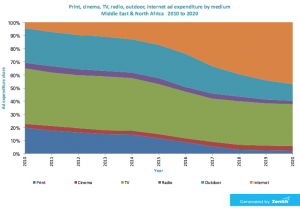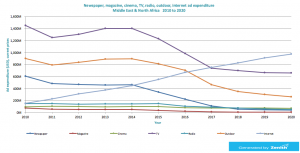January 15, 2018

In advertising, reach is not everything. A media strategy that aims for maximum reach at all costs may sacrifice creativity, positioning and engagement – it won’t necessarily generate the optimum ad spend return on investment (ROI). Cinema provides a platform that can target specific market segments in terms of both demographics and psychographics. Cinema advertising fulfils many of the objectives that a reach-oriented strategy misses out on, such as impact, high recall and audience engagement.
In an Adweek article from 2017, James Cooper, the editorial director, speaks about Screenvision Media unveiling a new creative launch pad ad unit at the 2017 Cannes Lions. Brands taking part in the initiative are eligible for the Hegarty Awards – to honour the best in cinema advertising. Cooper notes how “cinema provides a highly memorable impression in media, reinforced by a 59% ad-awareness statistic.”
Cinema has the benefit of a captive audience, and commercials on the big screen cannot easily be ignored. In addition, niche markets can be catered to. Take for instance a brand selling exclusive sports cars. Mass reach should not factor into their media plan. Instead, carefully crafted content delivered to the correct audience is a superior strategy for marketers and maximum reach should not be the default goal.
The same rule applies when scheduling movies at cinemas. Showing a film at every cinema in the country won’t necessarily produce best results. Reach is not everything — the relevance of a brand’s message to their target market being delivered through the correct channel, is what matters. Cinema provides quality audiences, rather than aiming for quantity.
Besides reach, other brand marketing goals might be awareness, brand positioning, brand affiliation, or short-term impact and hype. What’s important is to have a clear objective of what job the campaign and media should do and be able to measure it.
The need for integrated campaigns
Industry analytical tools are evolving, following the end of Amps and the imminent emergence of new media measurement methodologies, media currencies and segmentation models, marketers need to be clear about their campaign objectives. At the same time, we need to define and understand our audiences better. For instance, in the cinema space, there is a huge correlation between moviegoers and mallgoers, simply because a majority of movie houses in the Middle East are in shopping malls. This opens up possibilities for campaigns using cinema and out-of-home (OOH) activations around malls and in the broader cinema space. This also provides a fantastic opportunity for brand owners to keep their products top of mind within the retail environment. Besides this, there are collaboration opportunities between retail, brand and cinema.
For example, let’s look at Dubai – home to more than 55% of the world’s top international retail brands as well as world-class shopping malls such as The Dubai Mall and Mall of the Emirates. The retail potential of about 2.4 million Dubai residents was valued at Dh63 billion, or Dh26,137 per head in 2015, and was set to grow by 8.5 per cent per annum.
Dubai’s retail sector has witnessed remarkable growth in recent years and the emirate was named the second most important international shopping destination globally after London in 2015 – according to real estate consultancy firm CBRE.
Consumer purchase decisions can be influenced using the various advertising opportunities within malls — including cinema. Hence, there is a need for integrated campaigns that creatively unlock these opportunities. These should be targeted campaigns that don’t aim for reach alone. Cinemas, if you think of it, are more than just the big screen – they are auditoriums and versatile spaces. They can also be used for live broadcasts and conferences to reach a wider audience than just moviegoers.
Cinema is innovating in the marketing of products and services as well as on the entertainment front – a medium open and flexible to collaborating with innovators in all parts of the media space. Cinema advertising complements other media and advertisers and brand managers will find better ROI if they get that science right. The key is to use the versatility of cinema to drive and execute campaigns.
Cinema is uniquely immersive
As a recent Millward Brown white paper points out, one of cinema’s unique selling points is its minimal distractions compared to other media. Multi-screening is still not socially accepted in movie theatres, and ads can also not be skipped or muted.
With wall-to-wall screens, surround sound and its dark environment, cinema is uniquely immersive, so cinema viewers process movie advertising more consciously, which yields results other advertising mediums cannot.
Millward Brown research also shows that the impact of cinema advertising is boosted substantially when people see ads on cinema plus one other screen. This cross-channel synergy contributes on average 20-35% of overall brand effects. Particularly with TV.
For brands wanting their message to have impact with high recall, cinema is the perfect platform. It also provides an opportunity to stretch a campaign creatively, because advertising content has got to be great in the cinema space. The cinema space pushes the boundaries of creativity.
The big screen alone won’t give brands the reach of TV or radio, but a multi-platform strategy offers the best of both worlds. Combining cinema and TV is unparalleled in terms of ROI. The two-visual media complement each other.
In the US – always a bellwether of industry trends – there are already indications of advertisers moving from TV to cinema. The US saw a 1-2% decline in national TV advertising in Q1 2017, according to Pivotal Research Group, while cinema advertising reported 5.8 percent year-on-year growth in 2016.
As advertising budgets get tighter, we need to focus on offering marketers value, and strategists need to create innovative media plans to help achieve their goals.
There have long been a few dominant media types that every media strategist and media buyer recommend. But, some media types are oversubscribed, and now provide less attractive returns. Perhaps strategists need to look to supplementary media to stretch budgets further and move into areas with less clutter.
Opportunities for experimental, experience activations
Gone are the days when cinema advertising was just about screen time accompanied by a call-to-action. An integrated campaign can now embrace branding on popcorn boxes, cinema lightboxes and plasma screens, screens above the candy bar, and sampling stands and activities in the foyer, concourse and auditoriums of cinemas (to name a few). Cinevations (cinema activations which engage audiences) are another popular form of advertising in cinemas.
Media strategists can bundle this high-impact, experiential advertising with another media like TV, radio or print. TV will give you reach, and you can deliver the experiential elements at cinemas.
Cinema makes up 3.41% of the total advertising revenue in MENA as of 2017, according to Zenith. Although cinema advertising in MENA has gone down by 5%, Motivate Val Morgan’s turnover has gone up by 2% in the UAE in 2017. Cinema may not be a huge share of the market, however, it’s one of the only mediums, apart from digital, that hasn’t seen a drastic decline over the years. It is also a medium that can be regionalised or localised — advertisers have the opportunity to limit their campaigns to just a few relevant sites.

Courtesy: Zenith

Courtesy: Zenith
Cinema is all about the experience – the smell of the popcorn, nachos, slush, dimming of the lights and sound, which brands need to optimally embrace to their advantage.
Cinema doesn’t compete with other advertising mediums, it complements them and remains a powerful, targeted, high-impact media experience with a highly responsive audience. Brand owners would see results if they take a broader and more integrated view which incorporates cinema when bringing their products/services to the market.
Cinema is the unique ingredient that brings targeted, quality, creative expression to campaigns, filling in the gaps of a one-size fits-all approach. With growing interest and innovative solutions, the medium is returning to take its rightful place as a key weapon in the targeted advertising arsenal.
The big screen is limitless in bringing campaigns to life!
Sources: SAWA, BIZCOMMUNITY (Cinema News), Emirates 24/7 (Business) and Zenith